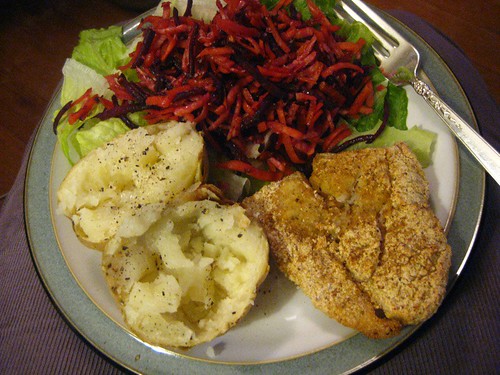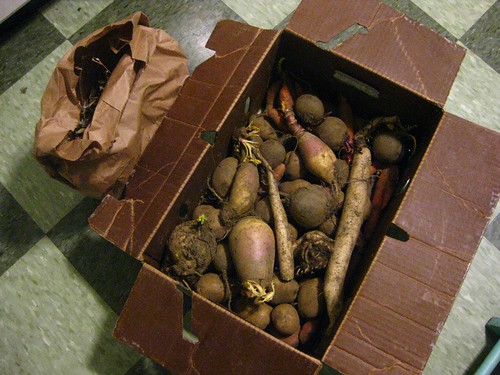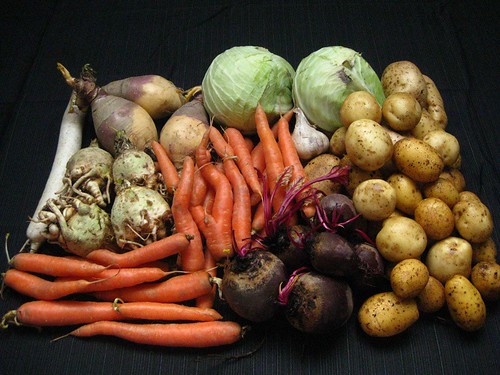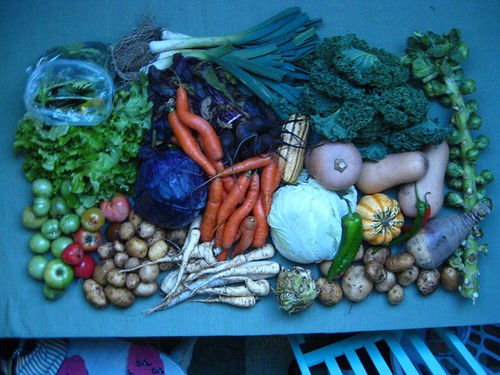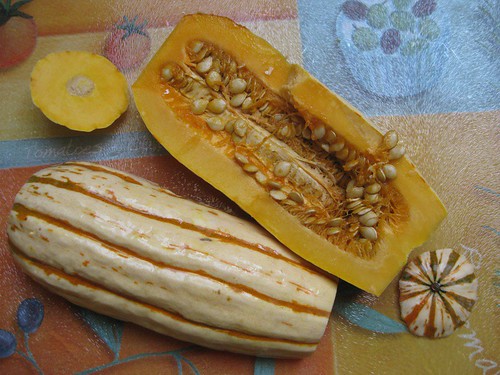This week's salad is without question the best salad I have ever had. The recipe for the shredded root veg slaw came via email from a fellow CSA member after several people had asked for recommendations on how to deal with all the root veggies. The root veg mix is delicious and keeps well in the fridge for several days; I've enjoyed having it on hand so I can serve it as a side dish, add some color to a tossed salad, or, as in this case, make it the centerpiece of a hearty salad entree.
We enjoyed this salad on Friday the 13th as part of our early Valentine's celebration, since we had plans with friends on the day itself. For the past few years, our Valentine's routine has been to pop a bottle of champagne, order Thai or Chinese, and make creme brulee (Dan's favorite). However, this year, since we're trying to spend less, I nixed the takeout and budgeted $10 for good cheese instead, planning to serve it along with a salad. We also postponed the creme brulee since this month is packed with desserts already (some of which you've already seen).
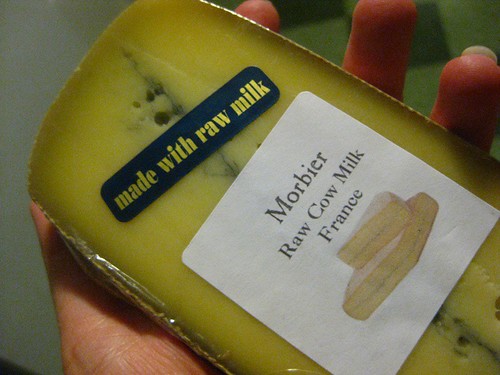
Picking the cheese was hard because there were so many amazing selections at the Coop. I went in thinking I'd like something local and made from raw goat's milk. Since we live right on the border with Vermont, the local options are abundant. However, some of the imported cheeses looked so tempting that my resolve wavered. Ultimately, I decided to split the budget, selecting one imported, semisoft, raw, cow's milk cheese and one local, soft, pasteurized, goat's milk cheese. We snacked on the imported cheese, a Morbier from France, while I grated the veggies for the salad and Dan did the dishes. Morbier is a creamy, slightly bitter cheese with a pungent smell but a mild and faintly nutty taste. It is made of two layers, separated by ash; traditionally, farmers would pour leftover curds from Gruyere de Comte in to a mold in the evening, then cover it with a layer of ash to preserve it, and top it off with more curds from the next morning's batch. Now it is generally made from one batch but the ash layer is kept for tradition. We both enjoyed this cheese very much, but I'm not sure I'd buy it again soon; there are just too many cheeses out there that I haven't tried yet.
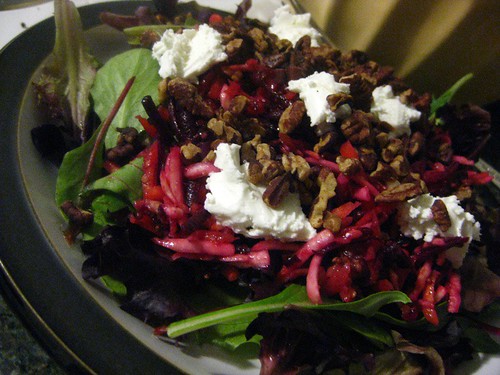
The local chevre went on top of the root veg slaw, along with some toasted pecans, all with a bed of mesclun. The combination was simple but fantastic. You know how when you taste something delicious, the first few bites taste the best, but then you sort of get used to it? That didn't happen with this salad. With every bite, I was surprised; every forkful was bursting with flavor and new taste. I think it's just the perfect balance of earthy, tangy, sweet, and nutty flavors, and the mix of textures - smooth, crunchy, crisp - offers so much variety that it stays interesting even if you eat a huge platter. We've already repeated this salad and I know it will become a regular menu item for us.
Judi's Winter Root Salad8 cups grated root vegetables (beets, turnips, carrots, daikon, celeriac, etc., plus one garlic clove)
1 tablespoon Dijon mustard
2 tablespoons olive oil
1.5 tablespoons vinegar
Mix it all together. Lasts in the refrigerator for several days. I omitted the garlic and used a German stone-ground mustard instead. I only used beets, carrots, and celeriac in mine. Grating all these veggies by hand would be a pain (literally, for my bad wrists); my yard-sale Salad Shooter does the trick in two minutes.
Best Winter Salad
4 cups mesclun (rinsed and spun)
3 cups Judi's Winter Root Salad
2 oz chevre (about half a small log)
1/3 cup chopped pecans
Set oven to 300. Spread pecans on an ungreased cookie sheet and toast in oven until they smell wonderful (about eight minutes). Divide mesclun between two plates. Scoop half of the root veg slaw on to each plate. Top each serving with dollops of chevre and toasted pecans. Serves 2.
